【英语】 倒装句考点解析(Word版附答案)(word)1
- 格式:doc
- 大小:100.00 KB
- 文档页数:11
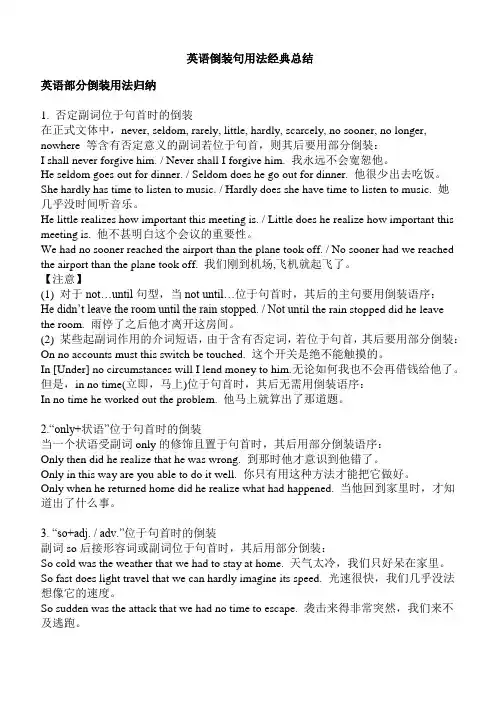
英语倒装句用法经典总结英语部分倒装用法归纳1. 否定副词位于句首时的倒装在正式文体中,never, seldom, rarely, little, hardly, scarcely, no sooner, no longer, nowhere 等含有否定意义的副词若位于句首,则其后要用部分倒装:I shall never forgive him. / Never shall I forgive him. 我永远不会宽恕他。
He seldom goes out for dinner. / Seldom does he go out for dinner. 他很少出去吃饭。
She hardly has time to listen to music. / Hardly does she have time to listen to music. 她几乎没时间听音乐。
He little realizes how important this meeting is. / Little does he realize how important this meeting is. 他不甚明白这个会议的重要性。
We had no sooner reached the airport than the plane took off. / No sooner had we reached the airport than the plane took off. 我们刚到机场,飞机就起飞了。
【注意】(1) 对于not…until句型,当not until…位于句首时,其后的主句要用倒装语序:He didn’t leave the room until the rain stopped. / Not un til the rain stopped did he leave the room. 雨停了之后他才离开这房间。
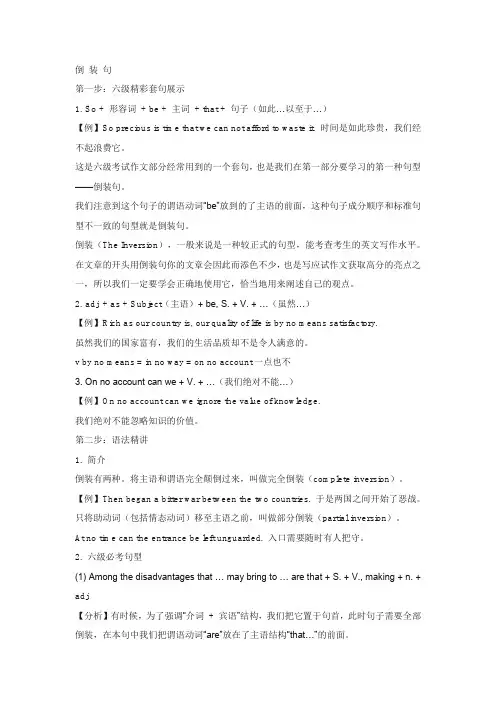
倒装句第一步:六级精彩套句展示1. So + 形容词+ be + 主词+ that + 句子(如此…以至于…)【例】So precious is time that we can not afford to waste it. 时间是如此珍贵,我们经不起浪费它。
这是六级考试作文部分经常用到的一个套句,也是我们在第一部分要学习的第一种句型——倒装句。
我们注意到这个句子的谓语动词“be”放到的了主语的前面,这种句子成分顺序和标准句型不一致的句型就是倒装句。
倒装(The Inversion),一般来说是一种较正式的句型,能考查考生的英文写作水平。
在文章的开头用倒装句你的文章会因此而添色不少,也是写应试作文获取高分的亮点之一,所以我们一定要学会正确地使用它,恰当地用来阐述自己的观点。
2. adj. + as + Subject(主语)+ be, S. + V. + …(虽然…)【例】Rich as our country is, our quality of life is by no means satisfactory.虽然我们的国家富有,我们的生活品质却不是令人满意的。
v by no means = in no way = on no account一点也不3. On no account can we + V. + …(我们绝对不能…)【例】On no account can we ignore the value of knowledge.我们绝对不能忽略知识的价值。
第二步:语法精讲1. 简介倒装有两种。
将主语和谓语完全颠倒过来,叫做完全倒装(complete inversion)。
【例】Then began a bitter war between the two countries. 于是两国之间开始了恶战。
只将助动词(包括情态动词)移至主语之前,叫做部分倒装(partial inversion)。

一、全部倒装全部倒装是只将句子中的谓语动词全部置于主语之前。
此结构通常只用与一般现在时和一般过去时。
常见的结构有:1) here, there, now, then, thus 等副词置于句首, 谓语动词常用be, come, go, lie, run 。
There goes the bell.Then came the chairman.Here is your letter.2)表示运动方向的副词或地点状语置于句首,谓语表示运动的动词。
Out rushed a missile from under the bomber.Ahead sat an old woman.注意:上述全部倒装的句型结构的主语必须是名词,如果主语是人称代词则不能完全倒装。
Here he comes. Away they went.二、部分倒装部分倒装是指将谓语的一部分如助动词或情态倒装至主语之前。
如果句中的谓语没有助动词或情态动词,则需添加助动词 do, does 或 did ,并将其置于主语之前。
1)句首为否定或半否定的词语,如no, not, never, seldom, little, hardly, at no time, in no way, not until...等。
Never have I seen such a performance.Nowhere will you find the answer to this question.Not until the child fell asleep did the mother leave the room.当 Not until 引出主从复合句,主句倒装,从句不倒装。
注意:如否定词不在句首不倒装。
I have never seen such a performance.The mother didn't leave the room until the child fell asleep.典型例题1) Why can't I smoke here?At no time___ in the meeting-roomA. is smoking permittedB. smoking is permittedC. smoking is it permittedD. does smoking permit答案 A. 这是一个倒装问题。

专题十特殊句式一、倒装句1.全部倒装(1)在There be/seem/appear/live/stand/lie/fly/exist/remain等存在句中。
Look,there’s that bookshop I was telling you about.(2)表示时间、地点和动作转移的副词如here,there,now,then,up,down,in,away,out等置于句首时,为使生动地描述情景而采用倒装语序。
此时,句子多用一般现在时或一般过去时。
There goes the phone.I’ll answer it.(3)such作表语置于句首时。
Such was Albert Einstein,a simple man but the 20th century’s greatest scientist.(4)直接引语的全部或部分位于句首时。
“If you die,who will get your money?” asked Holmes.(5)表示地点的介词短语位于句首时。
In the center of the square stands a monument.(6)为平衡句子结构,或使上下文衔接紧密,而将作表语的介词短语、形容词、副词或分词提到句首,引起倒装。
Gone forever are the days when the Chinese people had to use foreign oil.2.部分倒装在下列几种情况下,只把助动词、系动词或情态动词放在主语之前,构成部分倒装。
(1)little,never,not,seldom,neither,nor,hardly,rarely,by no means,at no time,under no circumstances,in no case等表示否定意义的单词或短语位于句首时。
Little does he care about what others think.(2)在not...until...,no sooner...than...,scarcely/hardly...when...,not only...but also...,neither...nor...等句式中。
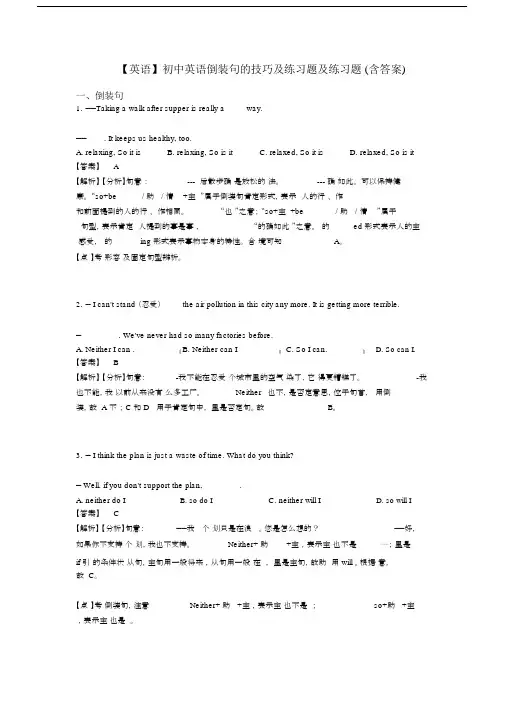
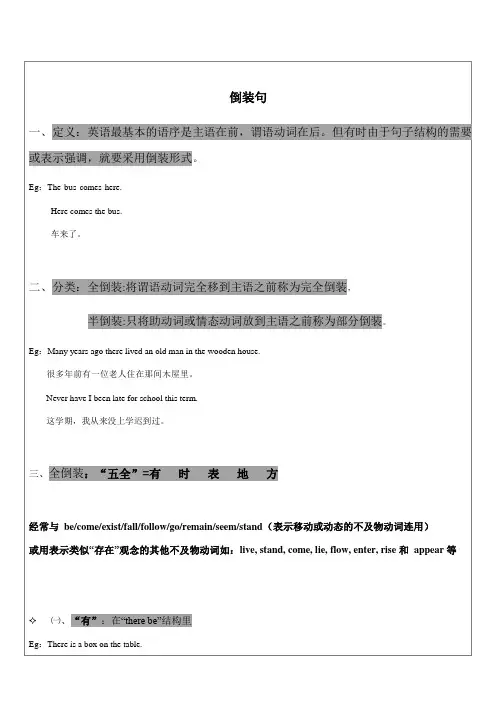
桌子上面有一个盒子。
✧㈡、“时”:表示时间副词,如:now,then,
Eg:Now comes your turn.
现在轮到你了。
✧㈢、“表”:表语放句子前,“表语+系动词+主语” 的结构
Eg:Present at the party were Mr. Green and many other guests.
格林先生和其他的客人在这个聚会上。
Seated on the ground are a group of young men.
一群年轻人坐在了地上。
✧㈣、“地”:地点状语放在句首
Eg:In south of the river lies a small factory.
小工厂位于河的南方。
From the valley came a cry.
山谷传来一阵哭声。
✧㈤、“方”:表方位的副词here, there 或out, in, up, down, away, off 等标志词放在句首 Eg:There lies a large wheat field in front of the house.
房子前面有一大片麦田。
Off all the lights went when I came in.
当我进来时,所有的灯都灭了。
四、半倒装:“八部”=不只让步也常需(虚)如此祝福✧㈠、“不”表示否定。
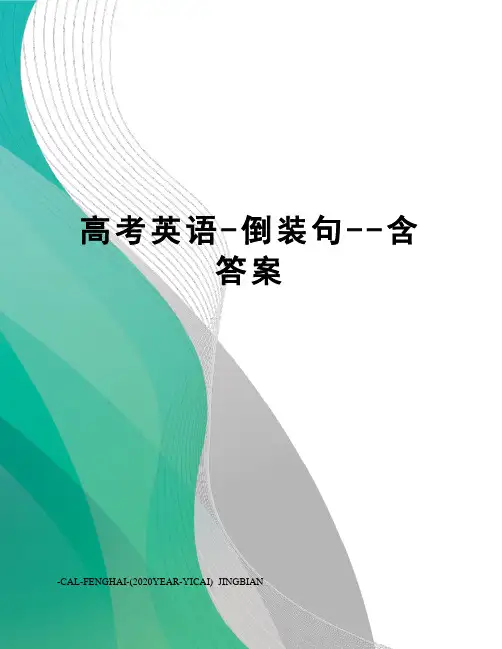
高考英语-倒装句--含答案-CAL-FENGHAI-(2020YEAR-YICAI)_JINGBIAN高考英语--倒装句一、倒装句考点解析倒装句有以下六大考点:(1)含有否定意义的副词放在句首引起的部分倒装(2)含有否定意义的连接词置于句首引起的部分倒装(3)“so(nor, neither)+助动词 + 主语”与“so(nor, neither)+主语+助动词”之间的区别以及与“ so + 主语+ 助动词”的句式区别(4)省略if的虚拟条件句以had / were / should开头引起的部分倒装(5)not until置于句首引起后面句子的部分倒装(6)only短语置于句首引起的部分倒装二、方法技巧点拨1. 考前应认真研读高考题目,了解命题人的意图,对高考方向有所把握。
2.从多方面入手,熟悉各种倒装句式,以不变应万变。
3.要注意倒装句中的主谓一致、时态一致及人称一致等问题。
4.加强理解分析能力,切忌机械记忆,注意知识间的交叉,分清句子成分。
5.在平时的学习中尽最大努力运用所学知识,达到熟能生巧的目的。
三、考点精讲定义:英语最基本的语序是主语在前,谓语动词在后。
但有时由于句子结构的需要或表示强调,就要采用倒装形式。
将谓语动词完全移到主语之前称为完全倒装,只将助动词、系动词、或情态动词放到主语之前称为部分倒装。
(一)完全倒装的情况:①There be 句型表示“存在”时,there是引导词,主语在be后,此时为全部倒装。
注意:1.be与其后的主语保持数的一致。
2.其中be有时可用live, stand, lie, seem, happen , appear, come, remain代替。
eg. There is a box on the table.②在以here, there, now, then, such等副词开头的某些句子里,谓语动词是be, go, come等时用全部倒装。
eg. There goes the bell.Here is an apple for you.Then came a new difficulty. 然后产生了一个新的困难。
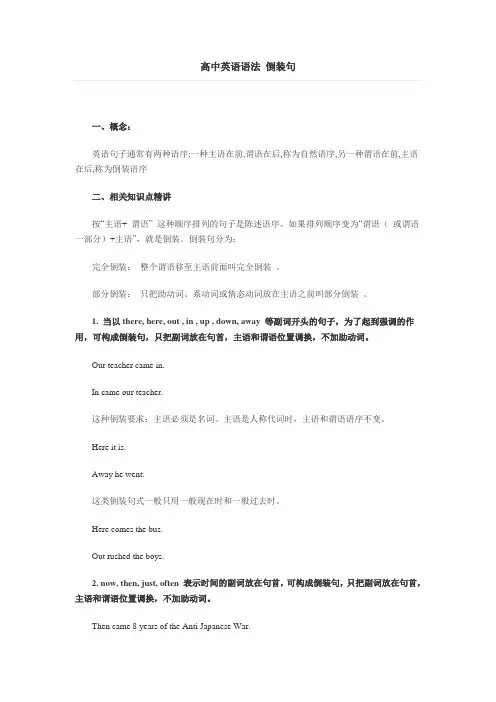
高中英语语法倒装句一、概念:英语句子通常有两种语序:一种主语在前,谓语在后,称为自然语序,另一种谓语在前,主语在后,称为倒装语序二、相关知识点精讲按“主语+ 谓语” 这种顺序排列的句子是陈述语序。
如果排列顺序变为“谓语(或谓语一部分)+主语”,就是倒装。
倒装句分为:完全倒装:整个谓语移至主语前面叫完全倒装。
部分倒装:只把助动词、系动词或情态动词放在主语之前叫部分倒装。
1. 当以there, here, out , in , up , down, away 等副词开头的句子,为了起到强调的作用,可构成倒装句,只把副词放在句首,主语和谓语位置调换,不加助动词。
Our teacher came in.In came our teacher.这种倒装要求:主语必须是名词。
主语是人称代词时,主语和谓语语序不变。
Here it is.Away he went.这类倒装句式一般只用一般现在时和一般过去时。
Here comes the bus.Out rushed the boys.2. now, then, just, often 表示时间的副词放在句首,可构成倒装句,只把副词放在句首,主语和谓语位置调换,不加助动词。
Then came 8 years of the Anti Japanese War.3. 表地点状语的介词短语放在句首,要用倒装句式,以示强调。
这种倒装句也是主谓直接调换位置,不加助动词did, does或do.Under a big tree ________, half asleep.A. did sat a fat manB. a fat man satC. did a fat man satD. sat a fat man4. there放在句首时,要用倒装句式。
在“there + be”结构中的谓语动词有时不用be , 而用表示类似“存在”观念的其他不及物动词。
如:live, stand, come, lie, flow, enter, rise 和appear等。
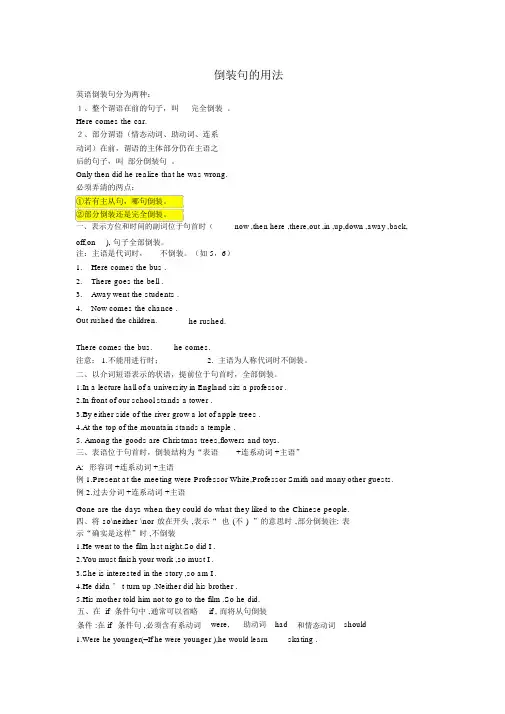
倒装句的用法英语倒装句分为两种:1、整个谓语在前的句子,叫完全倒装。
Here comes the car.2、部分谓语(情态动词、助动词、连系动词)在前,谓语的主体部分仍在主语之后的句子,叫部分倒装句。
Only then did he realize that he was wrong.必须弄清的两点:①若有主从句,哪句倒装。
②部分倒装还是完全倒装。
一、表示方位和时间的副词位于句首时(now ,then here ,there,out ,in ,up,down ,away ,back,off,on ), 句子全部倒装。
注:主语是代词时,不倒装。
(如 5,6)1.Here comes the bus .2.There goes the bell .3.Away went the students .4.Now comes the chance .Out rushed the children. he rushed.There comes the bus. 注意: 1.不能用进行时;he comes.2. 主语为人称代词时不倒装。
二、以介词短语表示的状语,提前位于句首时,全部倒装。
1.In a lecture hall of a university in England sits a professor .2.In front of our school stands a tower .3.By either side of the river grow a lot of apple trees .4.At the top of the mountain stands a temple .5. Among the goods are Christmas trees,flowers and toys.三、表语位于句首时,倒装结构为“表语+连系动词 +主语”A:形容词 +连系动词 +主语例 1.Present at the meeting were Professor White,Professor Smith and many other guests. 例 2.过去分词 +连系动词 +主语Gone are the days when they could do what they liked to the Chinese people.四、将 so\neither \nor 放在开头 ,表示“ 也 (不 )”的意思时 ,部分倒装注: 表示“确实是这样”时 ,不倒装1.He went to the film last night.So did I .2.You must finish your work ,so must I .3.She is interested in the story ,so am I .4.He didn ’ t turn up .Neither did his brother .5.His mother told him not to go to the film .So he did.五、在 if 条件 :在 if 条件句中 ,通常可以省略条件句 ,必须含有系动词if , 而将从句倒装were,助动词had 和情态动词should1.Were he younger(=If he were younger ),he would learn skating .2.Should they forget (=If they should forget ) to bring a map with them ,they would get lost inthe woods .3.Had they realized (=If they had realized ) how important the task was ,they wouldn ’ t have refused to accept .4.Were I you ,I would help her .六、否定词或半否定词(never .little ,seldom ,not ,nowhere ,scarely ,few ,by no means ,at no time ) 位于句首 ,应部分倒装1.Never have I been there .2.Little did I know about it .3.Seldom did she come late to school .4.Not a single mistake did he make .5.By no means should you buy that kind of car .七、以 not until,no sooner than , hardly when ,not only but also 所引导的状语放在句首时 ,需要部分倒装1.Not until 10 ’clock will the library open .2.No sooner had I gone out than he came to see me .3.Hardly had the train arrived when I ran to meet my friend.4.Not only does she speak English but also she follows the British way of life .八、 only及其修饰的状语位于句首时,后面的句子部分倒装。
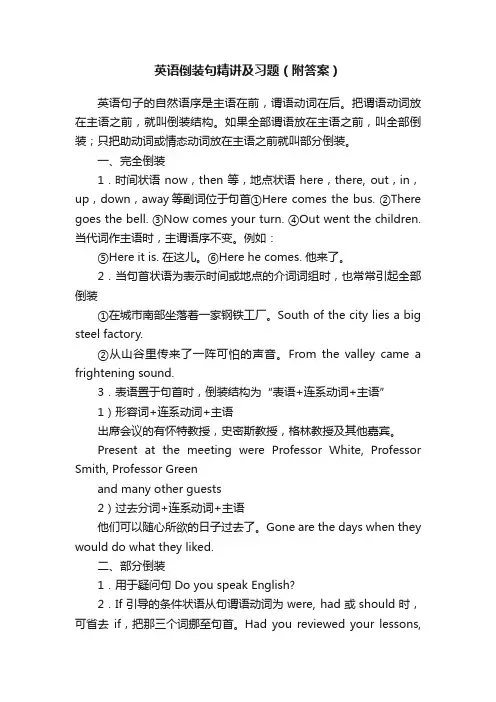
英语倒装句精讲及习题(附答案)英语句子的自然语序是主语在前,谓语动词在后。
把谓语动词放在主语之前,就叫倒装结构。
如果全部谓语放在主语之前,叫全部倒装;只把助动词或情态动词放在主语之前就叫部分倒装。
一、完全倒装1.时间状语now,then等,地点状语here,there, out,in,up,down,away等副词位于句首①Here comes the bus. ②There goes the bell. ③Now comes your turn. ④Out went the children. 当代词作主语时,主谓语序不变。
例如:⑤Here it is. 在这儿。
⑥Here he comes. 他来了。
2.当句首状语为表示时间或地点的介词词组时,也常常引起全部倒装①在城市南部坐落着一家钢铁工厂。
South of the city lies a big steel factory.②从山谷里传来了一阵可怕的声音。
From the valley came a frightening sound.3.表语置于句首时,倒装结构为“表语+连系动词+主语”1)形容词+连系动词+主语出席会议的有怀特教授,史密斯教授,格林教授及其他嘉宾。
Present at the meeting were Professor White, Professor Smith, Professor Greenand many other guests2)过去分词+连系动词+主语他们可以随心所欲的日子过去了。
Gone are the days when they would do what they liked.二、部分倒装1.用于疑问句Do you speak English?2.If引导的条件状语从句谓语动词为were, had或should时,可省去if,把那三个词挪至句首。
Had you reviewed your lessons,you might have passed the examination.Were there enough hands, we should go on with the project.Should I be free tomorrow, I will come to the party.3.用于“形容词(或名词、动词)+as(though)引导的让步状语从句中”①Pretty as she is, she is not clever. ②Try as he could, he might fall again.如果从句的表语是名词,其名词前不加任何冠词。
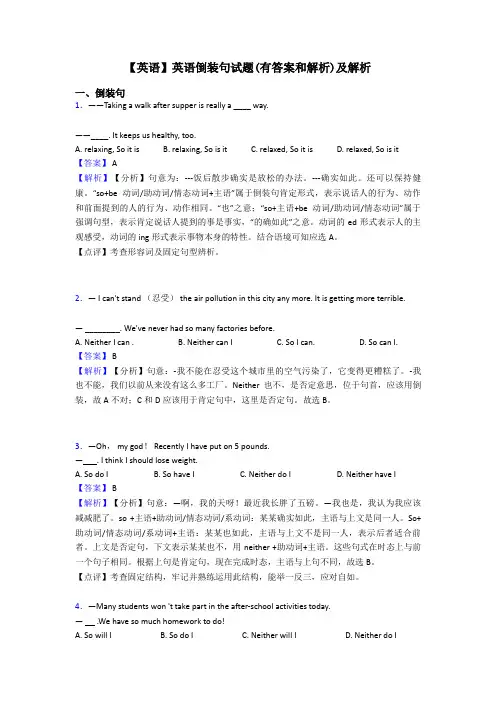
【英语】英语倒装句试题(有答案和解析)及解析一、倒装句1.——Taking a walk after supper is really a ____ way.——____. It keeps us healthy, too.A. relaxing, So it isB. relaxing, So is itC. relaxed, So it isD. relaxed, So is it【答案】 A【解析】【分析】句意为:---饭后散步确实是放松的办法。
---确实如此。
还可以保持健康。
“so+be动词/助动词/情态动词+主语”属于倒装句肯定形式,表示说话人的行为、动作和前面提到的人的行为、动作相同。
“也”之意;“so+主语+be动词/助动词/情态动词”属于强调句型,表示肯定说话人提到的事是事实,“的确如此”之意。
动词的ed形式表示人的主观感受,动词的ing形式表示事物本身的特性。
结合语境可知应选A。
【点评】考查形容词及固定句型辨析。
2.— I can't stand (忍受) the air pollution in this city any more. It is getting more terrible.— ________. We've never had so many factories before.A. Neither I can .B. Neither can IC. So I can.D. So can I.【答案】 B【解析】【分析】句意:-我不能在忍受这个城市里的空气污染了,它变得更糟糕了。
-我也不能,我们以前从来没有这么多工厂。
Neither也不,是否定意思,位于句首,应该用倒装,故A不对;C和D应该用于肯定句中,这里是否定句。
故选B。
3.—Oh, my god! Recently I have put on 5 pounds.— . I think I should lose weight.A. So do IB. So have IC. Neither do ID. Neither have I【答案】 B【解析】【分析】句意:—啊,我的天呀!最近我长胖了五磅。
(完整版)倒装句全面讲解和练习(答案)初中英语倒装句(一)倒装句的意义1、适应一定的语法结构的需要,主要是指疑问句句型结构的需要。
E.g. Was the People’s Liberation Army founded in 1927?2、为了强调某一部分,而把这部分放到句首,构成倒装。
e.g. Never have I been late for school this term.(二)倒装的使用情况一、部分倒装:就是把谓语中的be动词、助动词或情态动词置于主语前面。
常见于下列几种情况:(一). only所修饰的副词,介词短语或状语从句放在句首时,要用:only+ 状语+ be /助动词/情态动词+主语及其他例如:Only when he told me the news did I know what had happened.注意:only修饰主语时,不需要倒装。
例如:Among all the people, only you know the truth.小试牛刀:Only in this way ________to make improvement in the operating system.A. you can hopeB. you did hopeC. can you hopeD. did you hope(二).含有否定意义的副词或连词放在句首时。
如:never, little, seldom, not, not only, not until, no sooner (…than), hardly (…when), rarely, scarcely, in no way等。
例如:We seldom get up at four in the morning.= Seldom do we get up at four in the morning.Not a single word from him could express his feelings.(1) hardly…when; scarcely…when…; no sooner…than… 可以用正常语序had hardly done when… did 或用倒装句式Hardly had +主语+ done when… did 句式。
显而易见,英语的基本语序是“主语+谓语”,这种语序称为陈述句语序或自然语序(normal word order),如果把谓语的全部或一部分置于主语之前,就称为倒装语序(inverted word order),当谓语全部置于主语之前,称为全部倒装(full inversion);当谓语一部分(如助动词或情态动词)置于主语之前,称为部分倒装(partial inversion)。
一、全部倒装(一)there be句型有时一些表示存在意义的不及物动词也可用于该句型,如:stand,lie,exist,live,remain,appear,come,happen,occur,rise等。
例句:Generally, there was a belief that the new nations should be sovereign and independent states, large enough to be economically viable and integrated by a common set of laws. (选自2007年Use of English)分析:该句是复合句,其中a belief与that the new nations should be sovereign and independent states互为同位语关系,形容词短语large enough to be...作定语修饰states。
译文:他们普遍认为新生的国家是拥有主权和完全独立的国家,大到经济上可运行良好,并由一套共同法律让各个新的独立国家联合起来。
(二)表示方向、地点的状语等词置于句首here,there,up,down,away,in,out,off等位于句首时,往往主谓倒装。
例句:Here is an example, which I heard at a nurses convention, of a story which works well because the audience all shared the same view of doctors.(选自2002年Text 1)分析:该句是复合句,which I heard at a nurses convention和which works well共同修饰story。
倒装句知识点总结(word)一、倒装句1.—More and more people prefer to walk rather than ride in cars.—________. Walking is good for health.A. So they areB. So are theyC. So they doD. So do they【答案】 C【解析】【分析】句意:——越来越多的人比起开车更喜欢走路。
——确实如此,走路对健康有好处。
A他们也是,B是啊,C是啊,D他们也是。
根据 Walking is good for health,可知表示确实是这样,起强调作用,用so+主语+助动词,因此排除B和D;再根据谓语prefer,实义动词,和主语people可知,应用助动词do,故选C。
【点评】考查倒装句,注意理解倒装句so do they和陈述句so they do的意义及用法区别。
2.—Will you go to the park tomorrow?—If you don't, ________.A. so do IB. so will IC. neither do ID. neither shall I 【答案】D【解析】【分析】句意:—明天你要去公园吗?—如果你不去,我也不去。
so +主语+助动词/情态动词/系动词:某某确实如此,与上文是同一人。
So+助动词/情态动词/系动词+主语:某某也如此,与上文不是同一人。
上文是否定句,下文表示某某也不,用neither +助动词+主语。
这些句式在时态上与前一个句子相同。
倒装句处在条件状语从句中,依据主将从现的原则,倒装句应用将来时态,故选D。
【点评】本题主要考查倒装句式,为了避免和前一句话的内容重复,英语中习惯用so,neither引导的倒装句。
其主语与前一句主语不是同一人。
So表示肯定,neighter表示否定。
其时态与前句的时态保持一致。
倒装句英语句子的自然语序是主语在前,谓语动词在后。
如果把谓语动词放在主语之前,就称为倒装结构;如果谓语全部放在主语之前,就称为完全倒装;如果只把助动词、be动词或情态动词放在主语之前,就称为部分倒装。
完全倒装1. 以here, there, now, then开头,谓语动词是be, come, go, follow 等词,主语为名词。
例:Now comes your turn to answer the questions.2. 以up, down, out, in, away, off 等表示移动方向的副词开头的句子, 谓语通常为go, come, rush, fly, fall 等不及物动词,主语为名词。
例:Out rushed the boy.【注意】以上两种句型中,若主语是代词,即使here, there, now, then, up, down, out, in, away, off 等放在句首,也不用倒装。
例:Out he rushed. Here you are!3. 表示地点的介词短语或副词(短语如on the wall, under the tree, in front of the house, in the middle of theroom等) 位于句首,谓语是不及物动词,主语是名词。
例:Between the two buildings stands a tall tree.East of the city lies a big river.4. 表语位于句首,构成“形容词/ 现在分词/ 过去分词+连系动词+主语” 结构。
例:Present at the meeting were Professor Smith and many other guests.5. 代词such作表语,位于句首时。
例:Such are the facts: no one can deny (拒绝) them.6. 保持句子平衡或使上下文衔接更紧密时。
(英语)英语专题汇编英语倒装句(一)含解析一、倒装句1.—Tara has made great progress in English this term.—_______, and ________.A. So she has; so have youB. So she has; so you haveC. So has she;so you haveD. So has she; so have you【答案】 A【解析】【分析】句意:塔拉这学期的英语取得了很大的进步。
她的进步的确大,你的也不小。
so,位于分句或句子的开头,这种结构通常表示前面所说的情况也适合于另一个人(或事物),表示“我也这样”之类的概念。
其句型可归纳为: so + be / have / 助动词 / 情态动词 + 主语。
如果第二分句只是重复前句的意思,用来表示赞同时,so之后的主语和谓语就不能颠倒。
so,开头的倒装句一定要与上句的时态保持一致。
so开头的倒装句中的助动词或情态动词要根据人称的变化而变换。
所以选A。
【点评】考查倒装句的用法。
2.—Many students won 't take part in the after-school activities today.— .We have so much homework to do!A. So will IB. So do IC. Neither will ID. Neither do I【答案】 C【解析】【分析】句意:—今天许多学生不愿意参见课外活动。
—我也不愿意。
我们有那么多作业要做。
So+助动词+主语,表示与前面的肯定形式一致,表示也。
Neither+助动词+主语,表示与前面的否定形式一致,表示也不。
这两种部分倒装结构中的助动词与前一句的助动词一致,根据Many students won 't take part in the after-school activities today.可知此处won't表示否定形式,故用Neither+will+主语,故选C。
(完整版)倒装句练习题及答案解析(可编辑修改word版)倒装句练习1.O nly when you have obtain sufficient data come to a sound conclusion.A.can youB.you canC.would youD.you would2.that this region was so rich in natural resources.A.Little he knewB.Little did he knowC.Little he did knowD.Little he had known3.N ever again political office after his 1928 defeat for the presidency.A.Alfred E.Smith seriously soughtB.seriously Alfred E.Smith soughtC.when did Alfred E.Smith seriously seekD.did AlfredE.S mith seriously seek4.O nly in recent years begun to realize that wild dogs, kept within bounds, often do more good than harm.A.people haveB.since people haveC.have peopleD.people who have5.N ot until I shouted at the top of my voice his head.A.that he turnedB.did he turnC.he didn’t turnD.he had turned6.received law degrees as today.A.Never so women haveB.The women aren’t everC.Women who have neverD.Never have so many women7.Not only about the food, he also refused to pay for it.A.the customer complainedB.when the customer complainedC.did the customer complainD.the customer did complain8.that they may eventually reduce the amount of labor needed on construction sites by 90 percent.A.Such construction robots are cleverB.So clever the construction robots areC.So clever are the construction robotsD.Such clever construction robots are9. do we go for picnics.A.CertainlyB.SometimesC.SeldomD.Once10.Her answer is not acceptable, and .A.neither am IB.either is mineC.neither is mineD.mine is neither11.So fast that it is difficult for us to imagine its speed.A.light travelB.travels the lightC.do light travelD.does light travel12.Smith is a good student and studies very hard, .A.so it is with MaryB.so does MaryC.so is MaryD.neither does Mary13. a little more time to think, he might have acted more sensibly.A.If he tookB.If he has takenC.Had he takenD.Should he take14.Beneath our feet that our life depends on for food and clothing.A.the earth layB.the earth liesC.lie the earthD.lies the earth15.Our eating habits have changed, our way of life, and the fuel we need forour bodies is also different.A.so isB.as hasC.which hasD.the same is16.the beginning of the 19th century did scientists know that all matter is made up of atoms. A. At B. By C. Up to D. Not until17.Hardly he got out of the court the reporters raised a lotof questions to him.A.had … whenB.had…thanC.did…whenD.has…than18.Many a time swimming alone.A.the boy wentB.went the boyC.did the boy goD.did go the boy19.Important his discovery was, it was regarded as a matter of no account in his time.A.toB.forC.asD.although20.According to the periodic table, still some elements undiscovered.A.there seem to beB.it seemsC.it seems to beD.here seems21.Here you want to see.A.the manager comes/doc/e4433380.html,es the manager /doc/e4433380.html,es a managerD.is coming a manager22.Barry can hardly drive a car, .A.so can’t MollyB.can’t Molly eitherC.Molly can’t tooD.neither can Molly23.for the leadership of the Party, we should not have succeeded.A.Had not it beenB.Had it not beenC.There wasD.Is there24.no air or water, there would be no life in the world.A.Were thereB.There areC.There wasD.Is there25.Not only the data fed into it, but it can also analyze them.A.the computer can memorizeB.can the computer memorizeC.do the computer memorizeD.can memorize the computer26.Not once his view of life.A.did the gentleman mentionB.the gentleman mentioned thatC.the gentleman mentionedD.does gentleman mentioned27.By no means their own language well.A.it is true that all English people knowB.is it true that do all English people knowC.it is true that do all English people knowD.is it true that all English people know28.No sooner the theatre than the film Tony began.A.reachedB.had I reachedC.I had reachedD.did I reach29.The world’s birth rates are on a decline and are the death rates.A.soB.alsoC.tooD.the same30.Typical of the new type of young people , who set a shining example to the whole nation. A. was Lei Feng B. were Lei Feng C. Lei Feng was D. Lei Feng were31.for the free tickets, I would not have gone to see the films so often.A.If it is notB.Were it notC.Had it not beenD.If they were not32.She didn’t want to buy it, .A.however good was itB.however good it wasC.for how good might it beD.for how good it might be33., it is always possible to find out its volume.A.Whatever the shape of a body may beB.The shape of a body may be whateverC.May whatever the shape of a body beD.Whatever may the shape of a body be34.the moment bell rang.A.The students out ran.B.Out ran the studentsC.Ran out the studentsD.Out the students ran35.Down and hurt his leg.A.fell the boyB.fell heC.did he fallD.did the boy fell36., his face as white as a sheet of paper.A.A boy rushing inB.In a boy rushedC.Rushed a boy inD.In rushed a boy37.and broke it.A.Down fell the coffee cupB.He dropped the coffee cupC.Down was the coffee cup fallenD.The coffee cup fell down38.different opinions on his question.A.There existB.There existingC.There existsD.There were existed39. a new textbook, two pencils and a dictionary.A.There beingB.There beC.There areD.There is40 Between the two buildings a tall tree.A.standsB.standingC.liesD.are41.On the ground a sick goat, whose life was in danger./doc/e4433380.html,y/doc/e4433380.html,ysC.lying/doc/e4433380.html,ying42.at the back of the room was a shy girl with two big eyes.A.SatB.SitC.SeatedD.Seating43.on the blackboard the names of those who were late yesterday.A.Written, wereB.Written, wasC.Writing, wasD.Writing, were44.The old couple have been married for 40 years and never once with each other.A.they had quarreledB.they have quarreledC.have they quarreledD.had they quarreled45.Not until all the fish in the river died how serious the pollution was.A.did the villagers realizeB.the villagers realizedC.the villagers did realizeD.didn’t the villagers realize46.---Do you know Jim quarreled with his brother?---I don’t know,.A.nor don’t I careB.nor do I careC.I don’t care neitherD.I don’t care a lso47.Only in this way to make improvement in the operating system.A.you can hopeB.you did haveC.can you hopeD.did you hope48.Only when your identity has been checked .A.you are allowed toB.you will be allowed inC.will you allow inD.will you be allowed in49., I have never seen anyone who’s as capable as John.A.As long as I traveledB.Now that I have traveled so muchC.Much as I have traveledD.As I have travel so much50., he knows a lot about space and satellite.A.A child as he isB.As he is a childC.Child althoughD.Child though he is51.So difficult it to live in an English-speaking country that I determined to learnEnglish.A.I have feltB.have I feltC.I did feelD.did I feel52.Little about his own safety, though he was in great danger himself.A.does he careB.did he careC.he caresD.he cared53.---It was careless of you to have left your clothes outside all night.---My God! .A.So did IB.So I didC.So were youD.So did you54.What would have happened, , as far as the river bank?A.Bob had walked fartherB.if Bob should walked fartherC.had Bob walked fartherD.if Bob walked farther55.I finally got the job I dreamt about. Never in my life so happy.A.did I feelB.I feltC.I had feltD.had I felt高中英语倒装句练习题及答案作者: 收集于网络1.can you expect to get a pay rise.A.With hard workB.Although work hardC.Only with hard workD.Now that he works hard2., mother will wait for him to have dinner together.A.However late is heB.However he is lateC.However is he lateD.However late he is3.Not until all the fish died in the river, how serious the pollution was.A.did the villagers realizeB.the villagers realizedC.the villagers did realizeD.didn’t the villagers realize4.Not until I began to work how much time I had wasted.A.didn’t realizeB.did I realizeC.I didn’t realizeD.I realized5.—Do you know Jim quarrel with his brother?—I don’t know,.A.nor don’t I careB.nor do I careC.I don’t care neitherD.I don’t care also6.Only by practicing a few hours every day be able to waste much time.B.can youC.you willD.will you7.Not until the early years of the19th century what heat is.A.man did knowB.man knewC.didn’t man knowD.did man know8.got into the room, the telephone rang.A.He hardly; thenB.Hardly had he; whenC.He had not; thanD.Not had he; when9.snacks and drinks,but they also brought cards for entertainment when they had a picnic in the fores t.A.Not only they broughtB.Not only did they bringC.Not only brought theyD.Not only they did bring10.—I don’t think I can walk any further.—, Let’s stop here for a rest.A.Neither can IB.Neither do IC.I didn’t think soD.I think so11.Only in this way do it well.A.must weB.we couldC.can we12.Hardly when it began to rain.A.had he arrivedB.arrived heC.he had arrivedD.did he arrive13.Jack is a student and studies at the No. 2 Middle School. .A.It was the same with MikeB.So it is with MikeC.So is MikeD.So does Mike14., I would have given you his address.A.If you asked meB.You had asked meC.Should you have asked meD.Had you asked me15.that they had made an important discovery in science.A.Little they realizedB. They had realized littleC.Little did they realize。
【英语】倒装句考点解析(Word版附答案)(word)1一、倒装句1.—Peter has made great progress in English recently.— . He has been studying so hard these days.A. So have heB. So he hasC. So he haveD. So has he【答案】 B【解析】【分析】句意:——彼得最近在数学反面取得重大进步。
——他就是这样,这些天他一直在努力学习。
在表示和上述发生相同事情时,用so+助动词+主语。
对别人情况加以肯定时常用,so+主语+助动词。
根据He has been studying so hard these days.可知是对上述事情的肯定。
主语是第三人称单数,助动词用has,故选B。
【点评】此题考查倒装结构。
主语部分倒装So+助动词+主语。
和So+主语+助动词。
两个句式区别。
2.一 I didn't watch the football match on TV yesterday.一 . I got home too late to watch it.A. So did IB. Neither did IC. So I didD. Neither I did【答案】 B【解析】【分析】neither/nor+助动词+主语,译为“某人(物)也不……”,如果上句是否定句,那么下句就是也不是这种情况;so+助动词+主语,意为“某人(物)也是……”如果上句是肯定句,那么下句就是也是这种情况。
用于这种结构的主语是不同的人,如果是上下的两句的主语是同一个人,则用半倒装结构,so+主语+助动词,表示“某人的确是这样”。
句意:—我没看昨天的聊天节目,—我也没看,我到家太晚而没有看。
结合句意,故选B。
3.-I don't know about you, but I'm sick and tired of this weather.-_______. I can't stand all this rain.A. I don't careB. It's hard to sayC. So am ID. I hope not【答案】 C【解析】【分析】A. I don't care 我不在乎 B. It's hard to say很难说C. So am I 我也是 D. I hope not我希望不要这样;句意:我不知道你的情况,但是我生病了,讨厌这种天气。
我也是,我忍受不了这雨了。
故选C【点评】“So+谓语+主语”此句型为倒装结构,其主语与上文句子中的主语是不同的。
so代表上句中陈述的肯定内容。
谓语可以是连系动词、情态动词或助动词,且必须与上句中的谓语动词保持时态的一致,意思为“…也是如此”。
“So+ 主 + 谓”表示讨论同一人做某事。
4.— All the students are working hard now.—_______. Because all of them want to go to good colleges.A. So are theyB. Neither they areC. So they areD. So they do【答案】 C【解析】【分析】句意:——所有的学生都在努力学习。
——确实如此。
因为他们都想要去好的大学。
so+助动词(情态动词或连系动词)+主语,……也是,前后主语不同。
so+主语+助动词,确实如此,前后主语一致。
根据下文all of them可知上下文主语是一致的,用“so+主语+助动词”。
上文助动词是are,下文也用are,故选C。
【点评】考查倒装句,注意so+助动词(情态动词或连系动词)+主语和so+主语+助动词的词义和用法。
5.—I haven't seen the interesting movie Let the Bullet(子弹)Fly.— _________.A. Neither have IB. So have IC. Neither I haveD. So I have【答案】 A【解析】【分析】 Neither have I我也没有;So have I我也一样;Neither I have我确实不;So I have确实是这样。
句意:我没有见过这不有趣的电影《让子弹飞》。
根据语境可知选A。
【点评】这几个倒装句的区别比较难。
“so+助动词(情态动词或连系动词)+另一主语”,此句型是主谓倒装结构,可以表示前面的情况也适用于后者,使用该句型需要注意以几个方面的问题:1.该句型只能用于肯定句,不能用于否定句:如果前句是否定句,则要用“neither /nor +助动词+主语”。
2.句型中的主语与上文中的主语是不同的两个主语3.句型中助动词,包括连系动词和情态动词的时态要和上句中谓语动词的时态相一致。
另一句型so+主语+助动词是指对上文的肯定,起加强作用。
6.--Peter knows many people here.---_________________A. So do IB. So am IC. Neither am ID. Neither do I【答案】 A【解析】【分析】So do I我也一样;So am I.我也是;Neither am I我也不;Neither do I 我也不。
句意:彼得认识这儿的许多人。
结合语境可知上文为一般现在时态,主谓结构,故选A。
【点评】这几个倒装句的区别比较难。
“so+助动词(情态动词或连系动词)+另一主语”,此句型是主谓倒装结构,可以表示前面的情况也适用于后者,使用该句型需要注意以几个方面的问题:1.该句型只能用于肯定句,不能用于否定句:如果前句是否定句,则要用“neither /nor +助动词+主语”。
2.句型中的主语与上文中的主语是不同的两个主语3.句型中助动词,包括连系动词和情态动词的时态要和上句中谓语动词的时态相一致。
另一句型so+主语+助动词是指对上文的肯定,起加强作用。
7.—Lily doesn't go to the museum this weekend. What about you, Millie?—If Lily doesn't go there, ____.A. so do IB. so will IC. neither do ID. neither will I【答案】 D【解析】【分析】句意:——莉莉这个周末不去博物馆。
你呢,米莉?——如果莉莉不去那儿,我也不去。
So+助动词+主语,表示主语也是;neither+助动词+主语,表示主语也不是这样。
根据if从句是一般现在时,主句用一般将来时。
主句是否定结构,可知此处倒装结构用neither或nor引导,故选D。
【点评】考查倒装句。
掌握so和neither引导的倒装结构的区别。
8.Only yesterday know the news.A. did heB. he didC. does heD. he does【答案】 A【解析】【分析】句意:昨天他才知道这个消息。
yesterday昨天,副词,only+副词放句首时用半倒装,一般过去时中含有实义动词的半倒装,用助动词did+主语+实义动词原形,故选A。
【点评】考查倒装句,注意倒装句的结构。
9.Only _________ save his life.A. can the doctorB. the doctor canC. will the doctorD. could the doctor【答案】 B【解析】【分析】句意:只有医生能挽救他的生命。
分析:only的倒装中一定注意他的用法,只有当only+状语(从句)至句首是才倒装这儿很明显是在强调主语doctor所以不用倒装,故选B【点评】倒装句的用法。
10.Only in this place ________ such beautiful water and mountains.A. we can findB. can we findC. we foundD. found we【答案】 B【解析】【分析】句意:只有在这个地方我们可以找到如此美丽的水和山。
only+状语(介词短语)位于句首,其后要部分倒装,故把情态动词后助动词放在主语前,情态动词+主语+谓语的语序,故选B。
【点评】考查倒装句,注意only+状语(介词短语)位于句首,其后要部分倒装的用法。
11.— I have never visited a paper factory.— .A. So have IB. I haven't nowC. Neither have I【答案】 C【解析】【分析】句意:-我从来没有参观过造纸厂。
-我也没去过。
根据句意可知这里表示的是否定的意思,故A可以先排除,因为so 的这个倒装的用法只能用在肯定句中,表示上面所说的情况也适用于另外一人。
在否定句应该用neither,当neither 位于句首时,应该用倒装的结构。
故选C。
【点评】考查倒装。
12.My sister went to the cinema, and _________________.A. so did IB. so have IC. neither did ID. neither have I【答案】 A【解析】【分析】句意:我姐姐去看电影了,我也是。
went是一般过去时,助动词是did,故排除B和D选项,省略句,so+助动词+主语,用于肯定句,……也是,neither+助动词+主语,用于否定句,……也是,根据My sister went to the cinema,可知是肯定句,故选A。
【点评】考查省略句,注意so+助动词+主语的用法。
13.— I have changed my job.— __________________.A. So do IB. So have IC. So I doD. So I have【答案】 B【解析】【分析】句意:——我已经换了工作。
——我也是。
根据时态是现在完成时故助动词是have,故排除A和C选项,so+助动词+主语,……也是,so+主语+助动词,的确是,此处表示我也是,故选B。
【点评】考查省略句,注意so+助动词+主语的用法。
14.—My brother got up very early last Sunday.—________.A. So I didB. So I wasC. So did I【答案】 C【解析】【分析】句意:——上星期天我哥哥起得很早。